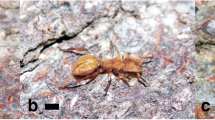Abstract
Paltothyreus tarsatus workers show an adaptive predatory strategy compatible with central place theory which predicts that single-prey loading is an extension of the optimal diet choice while multiple-prey loading behavior would correspond to the optimal use of patches. The insight learning involved in the quick modifications of predatory strategy enablesP. tarsatus to hunt all available prey in a great diversity of sizes and species. Nevertheless, this generalist predator strongly preferred termites and very large prey such as giant diplopods and crickets to other choices within its diet. In the hunting of these favorite prey, the recruitment of nestmates enhanced the efficiency of total predation, though the release of a chemical trail appeared to depend on the hunger-satiety balance of the colony. In addition to the hunger, the miscapture of prey also triggered the release of chemical trails. The strategy for capturing grouped termites was characterized by the loading of multiple prey at a single time, by a concentrated search in a restricted area and by an optional recruitment of nestmates. These behavioral characteristics of ponerine ants probably account for the flexibility of their predatory strategy for hunting aggregated small prey.
Similar content being viewed by others
References
Agbogba, C. 1985 Quelques observations sur le comportement de chasse de la PonérineMesoponera caffraria Smith (Hymenoptera, Formicidæ).Actes Coll. Insectes Sociaux 2: 235–238.
Arnold, G. 1915 A monograph of the Formicidæ of South Africa. Part I (Ponerinæ, Dorylinæ).Ann. S. Afr. Mus. 14: 1–163.
Caro, T.M. & P. bateson 1986 Organization and ontogeny of alternative tactics.Anim. Behav. 34: 1483–1499.
Charnov, E.L. 1976 Optimal foraging: attack strategy of mantid.Am. Nat. 110: 141–151.
Déjean, A. 1980 Le comportement de prédation deSerrastruma serrula Santschi (Formicidæ, Myrmicinæ). I. Capacité de détection des ouvrières, analyse des phases comportementales.Ann. Sci. Nat., Zool. (sér. 13) 2: 131–143.
Déjean, A. 1985 Etude éco-éthologique de la prédation chez les fourmis du genreSmithistruma (Formicidæ-Myrmicinæ-Dacetini). III. La capture des proies chez.S. emarginata.Insectes Sociaux 32: 241–256.
Déjean, A. 1986 Etude du comportement de prédation dans le genreStrumigenys (Formicidæ-Myrmicinæ).Insectes Sociaux 33: 388–405.
Déjean, A. 1987 Effect of prey size on predatory behavior ofSerrastruma serrula (Hymenoptera: Formicidæ, Myrmicinæ).Sociobiology 13: 295–306.
Déjean, A. 1988 Failure as an effective stimulus of a “reserve behavior” which allows the capture of alternative prey bySerrastruma serrula workers (Formicidæ-Myrmicinæ).Sociobiology 14: 325–339.
Déjean, A. 1991 Le comportement prédateur dePachycondyla soror.Entomol. exp. appl. 58: 123–135.
Déjean, A. & E. P. Bashingwa 1985. La prédation chezOdontomachus troglodytes Stanschi (Formicidæ-Ponerinæ).Insectes Sociaux 32: 23–42.
Déjean, A., G. Beugnon, & J.-P. Lachaud 1993 Spatial components of foraging behavior in an African ponerine ant,Paltothyreus tarsatus. J. Insect Behav., in press.
Déjean, A. & B. Corbara 1990 Predatory behavior of a neotropical arboricolous ant:Pachychondyla villosa (Formicidæ: Ponerinæ).Sociobiology 17: 271–286.
Déjean, A., D. Masens, K. Kanika, M. Nsudi & R. Gunumina 1986 Les termites et les fourmis, animaux dominants de la faune du sol de plusieurs formations forestières et herbeuses du Zaïre.Actes Coll. Insectes Sociaux 3: 237–283.
Gordon, D.M. 1989 Dynamics of task switching in harvester ants.Anim. Behav. 38: 194–203
Gordon, D.M. 1991 Behavioral flexibility and the foraging ecology of seed-eating ants.Am. Nat. 138: 379–411.
Hölldobler, B. 1976 Recruitment behavior, home range orientation and territoriality in harvester ants,Pogonomyrmex.Behav. Ecol. Sociobiol. 1: 3–44.
Hölldobler, B. 1980 Canopy orientation: a new kind of orientation in ants.Science 210: 86–88.
Hölldobler, B. 1984 Communication during foraging and nest-relocation in the African stink ant,Paltothyreus tarsatus Fabr. (Hymenoptera, Formicidæ, Ponerinæ).Z. Tierpsychol. 65: 40–52.
Hölldobler, B. & E.O. Wilson 1990The Ants. The Belknap Press of Harvard University Press, Cambridge, Massachusetts.
Lessells, C.M. & D.W. Stephens 1983 Central place foraging: single-prey loaders again.Anim. Behav. 31: 238–243.
Lévieux, J. 1966 Note préliminaire sur les colonnes de chasse deMegaponera foetens F. (Hyménoptère Formicidæ).Insectes Sociaux 13: 117–126.
Lévieux, J. 1972 Le rôle des fourmis dans les réseaux trophiques d'une savane préforestière de Côte-d'Ivoire.Ann. Univ. Abidjan (sér. E)5: 143–240.
Maschwitz, U., S. Steghaus-Kovac, R. Gaube & H. Hänel 1989 A South East Asia ponerine ant of the genusLeptogenys (Hym., Form.) with army ant habits.Behav. Ecol. Sociobiol. 24: 305–316.
Orians, G.H. & N.E. Pearson 1979 On the theory of central place foraging. InAnalysis of Ecological System (D.J. Horn, G.R. Stairs and R.D. Mitchell, eds.), pp. 155–177. Omo State University Press. Colombus.
Porter, S.D. & C.D. Jorgensen 1981 Foragers of the harvester ant,Pogonomyrmex owyheei: a disposable caste?Behav. Ecol. Sociobiol. 9 247–256.
Robertson, P.S. 1971 Pheromones involved in aggressive behavior in the antMyrmecia gulosa.J. Insect Physiol. 17: 691–715.
Schoener, T.W. 1979 Generality of the size-distance relation in models of optimal feeding.Am. Nat. 14: 902–914.
Schwartz, D. 1984.Méthodes Statistiques à l'Usage des Médecins et des Biologistes. Flammarion Médecine Sciences, Paris.
Thorpe, W.H. 1963Learning and Instincts in Animals. 2nd ed. Methuen, London.
Wheeler, W.M. 1922a Ants of the American Museum Congo Expedition, a contribution to the myrmecology of Africa. II. The ants collected by the American Museum Congo Expedition.Bull. Amer. Mus. Nat. Hist. 45: 39–269.
Wheeler, W.M. 1922bidem.Bull. Amer. Mus. Nat. Hist. 45: 711–1004.
Wheeler, W.M. 1936 Ecological relations of ponerine and other ants to termites.Proc. Amer. Acad. Arts & Sci. 71: 159–243.
Wroughton, R.C. 1982 Our ants.J. Bombay Nat. Hist. Soc. 7: 3–60.
Author information
Authors and Affiliations
About this article
Cite this article
Déjean, A., Lachaud, JP. & Beugnon, G. Efficiency in the exploitation of patchy environments by the ponerine antPaltothyreus tarsatus: an ecological consequence of the flexibility of prey capture behavior. J. Ethol. 11, 43–53 (1993). https://doi.org/10.1007/BF02350005
Received:
Accepted:
Issue Date:
DOI: https://doi.org/10.1007/BF02350005




